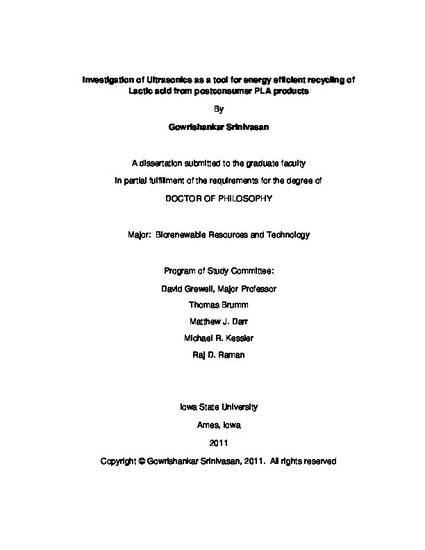
The growing use of "ecofriendly," biodegradable polymers have created a need for a suitable recycling technique because, unlike petroleum derived plastics, their properties deteriorate during conventional recycling. These new techniques must be cost efficient and yield material properties same as virgin polymer. This research investigates the effectiveness of high-power ultrasonics as an efficient technique to recover lactic acid from postconsumer polylactic acid (PLA) products. Polylactic acid is a commercially available bioplastic derived from corn starch and/or sugar cane that is biorenewable and compostable (biodegradable). The various ongoing researches to recover lactic acid from PLA employ a common platform of high temperature, high pressure (HTHP) to effect polymer hydrolysis. The energy intensiveness of these HTHP processes prompted this work to investigate ultrasonics as an low energy alternative process to cause PLA depolymerization. The energy consumption and the time required for depolymerization were utilized as the metrics to quantify and compare depolymerization enhanced by ultrasonics with hot-bath technique. The coupled effect of catalysts concentration and different solvents, along with ultrasonic were studied based on preliminary trial results. In addition, the correlation between the rates of de-polymerization was analyzed for ultrasonic amplitude, treatment time, and catalyst concentration and types. The results indicate that depolymerization of PLA was largely effected by heating caused by ultrasonic-induced cavitations. Other effects of ultrasonics, namely cavitations and acoustic streaming, were shown to have minimal effects in enhancing depolymerization. In fact, thermal energy predominately affected the reaction kinetics; the heat introduced by conventional method (i.e., electrical heaters) was more efficient than ultrasonic heating in terms of energy (for depolymerization) per unit mass of PLA and depolymerizing time. The degree of crystallinity also was an important factor that affected the reaction kinetics of depolymerization. It was found that amorphous PLA de-polymerized faster compared to semi-crystalline PLA under the same conditions. While the depolymerization of PLA was anticipated to require 15 to 30 minutes, or extreme conditions [40], it was determined that with K2CO3 or NaOH catalysts and methanol media as the conditions, PLA could be fully de-polymerized within a few minutes. This information provided insight for effective pathways for the depolymerization of PLA, reducing the environmental impact of material use on the environment.
The effects of the ultrasonics were modeled with finite element analysis based on fundamental concepts. The predictions from the modeling were confirmed by studying real-time streaming and fluid flow inside the treatment cell utilizing particle image Velocimetry (PIV). The FEA (finite element analysis) models of ultrasonic streaming were verified and were in reasonable agreement with the experimental values, validating simple assumptions for future researchers.
Available at: http://works.bepress.com/gowrishankar_srinivasan1/6/